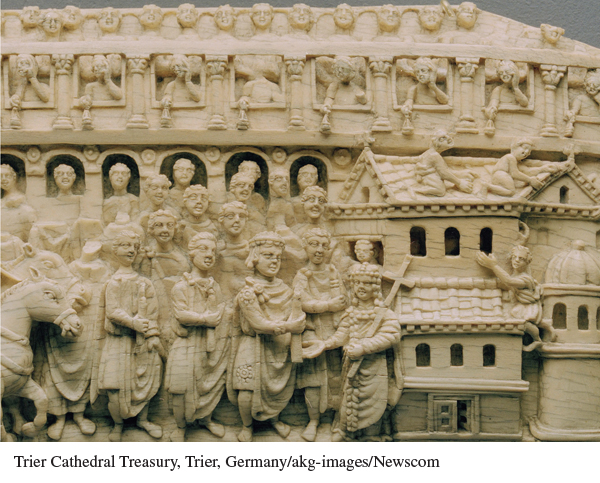A History of Western Society: Printed Page 184
A History of Western Society, Value Edition: Printed Page 173
A History of Western Society, Concise Edition: Printed Page 185
Introduction for Chapter 7
7
Late Antiquity
250–600
The Roman Empire, with its powerful — and sometimes bizarre — leaders, magnificent buildings, luxurious clothing, and bloody amusements, has long fascinated people. Politicians and historians have closely studied the reasons for its successes and have even more closely analyzed the weaknesses that led to its eventual collapse. From the third century onward, the Western Roman Empire slowly disintegrated. Scholars have long seen this era as one of the great turning points in Western history, a time when the ancient world was transformed into the very different medieval world. During the past several decades, however, focus has shifted to continuities as well as changes, and what is now usually termed “late antiquity” has been recognized as a period of creativity and adaptation, not simply of decline and fall.
The two main agents of continuity in late antiquity were the Christian Church and the Byzantine or Eastern Roman Empire. Missionaries and church officials spread Christianity within and far beyond the borders of the Roman Empire, bringing with them the Latin language and institutions based on Roman models. The Byzantine Empire lasted until 1453, a thousand years longer than the Western Roman Empire, and preserved and transmitted much of ancient Greco-

CHAPTER PREVIEW
How did Diocletian and Constantine try to reform the empire?
How did the Christian Church become a major force in the Mediterranean and Europe?
What were the key characteristics of barbarian society?
What were some of the causes and consequences of the barbarian migrations?
How did the church convert barbarian peoples to Christianity?
How did the Byzantine Empire preserve the legacy of Rome?
Chronology
| ca. 293 | Diocletian establishes the tetrarchy |
| 313 | Edict of Milan, allowing practice of all religions in the Roman Empire |
| 325 | Council of Nicaea |
| 354–430 | Life of Saint Augustine |
| 378 | Visigoths defeat the Roman army at Adrianople |
| 380 | Theodosius makes Christianity the official religion of the Roman Empire |
| 410 | Visigoths sack Rome |
| 429 | Vandals begin their conquest of North Africa |
| 476 | Odoacer deposes the last Roman emperor in the West |
| ca. 481–511 | Reign of Clovis |
| 493 | Theoderic establishes an Ostrogothic state in Italy |
| 527–565 | Reign of Justinian |
| 529 | The Rule of Saint Benedict |
| 535–572 | Byzantines reconquer and rule Italy |
| 597 | Pope Gregory I sends missionaries to Britain |